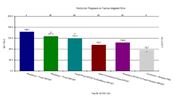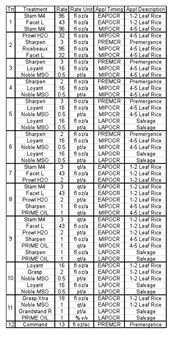|
Weed Control Study In Furrow Rice Outlined At Delta Center Field Day
JAMES HEISER
PORTAGEVILLE, MO.
Row rice production acres continue to increase in Missouri. While less time is spent constructing levees, installing and maintaining gates, etc., more effort and capital may be required for other aspects of production, namely fertility and weed control. It is a commonly held belief that rice is flooded because it is an efficient way to irrigate a very water dependent crop. However, approximately 85% of weed control in rice production is attributed to the flood. Growing rice without this layer of protection puts more pressure on our herbicides, and our producers, to make more timely applications than in flooded rice.
For the past two years, a study was implemented to discover if herbicides we use successfully in flooded rice production could be effective utilized in furrow irrigated rice production. In 2017, two replications of treatments were applied toward the crown end of the field. Personal observations and input from growers indicated this setting would offer the most difficult weed control conditions in this production system. A preemergence (PRE) application of Sharpen (1.5 fl. oz. /ac) and Command (21 fl. oz. /ac) was included in all treatments to evaluate postemergence (POST) program effectiveness. Treatments included 1) Ricebeaux + Facet on 4-5 leaf rice, 2) Ricebeaux + Prowl H2O, 4-5 leaf; 3) Facet + Prowl H2O 1-2 leaf followed by (fb) Ricebeaux at 4-5 leaf; 4) Stam + Grandstand + Facet 1-2 leaf; 5) Ricebeaux 1-2 leaf fb Sharpen + Facet 4-5 leaf; and 6) no POST . All treatments were applied at the proper rate for the soil type and crop stage and proper adjuvant included when required.
Palmer amaranth was the prevalent species in the study area, with pitted morningglory, horsenettle and yellow nutsedge also present. Visual weed control and crop response data were recorded on June 11, 19 and 27, and July 4 and 24, 2017. Treatment 2 had the most variability with Rep 1 providing only 50 percent control of Palmer while Rep 2 showed 93 percent control on the earliest rating date. This continued to be the case through the July 24 evaluation. All other treatments provided at least 90 percent control of palmer at the first evaluation and greater than 93 percent on the final evaluation. Rice yields were somewhat low compared to what one might expect in flooded rice production. Yields ranged from 77.7 bu./ac for the PRE only treatment up to 143.5 bu./ac for treatment 1 (Figure 1). The lowest yielding treatment that included a POST application was treatment 4 with 96 bu./ac. Only treatment 1 yielded significantly higher than the PRE only check. All other POST containing treatments yielded similar to treatment 1 and the PRE only check.
For 2018 a new treatment list was developed with an emphasis on full season programs with varied components and application timings. All treatments received an application of Command at a rate of 13 fl. oz./ac PRE. Complete treatment list shown in Table 1. Final evaluations have not been conducted at this time but results thus far indicate very few differences in control of Palmer amaranth control. Other weeds evaluated include broadleaf signalgrass, morningglory species, and yellow nutsedge. Populations of these weeds were generally variable and much less dense than Palmer amaranth. Crop injury has been observed but at very low levels and rice quickly recovered.
We intend to continue investigating new options and programs for this system as new herbicides and cultural practices are developed and adopted. ∆
JAMES HEISER: Research Associate, University of Missouri

Figure 1. Average rice grain yield (bu./ac) in non-flooded row rice production when
six herbicide programs were evaluated in 2017. All treatments received a pre-emergence
application of Sharpen and Command (1.5 and 21 fl. oz./ac, respectively).

Table 1. Herbicide treatment list for 2018 furrow irrigated rice study. Herbicide trade name,
application rate and timing, and application description shown. Treatment 12 (not shown)
was a PRE application of Command with no additional products applied
|
|